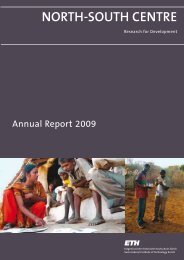Annual Report 2006/07 - ETH - North-South Centre North-South ...
Annual Report 2006/07 - ETH - North-South Centre North-South ...
Annual Report 2006/07 - ETH - North-South Centre North-South ...
You also want an ePaper? Increase the reach of your titles
YUMPU automatically turns print PDFs into web optimized ePapers that Google loves.
Research fellowChristine Zundel,SHL, ZollikofenSupervisorPeter Nagel, NLU,University of BaselCollaboratorsRachid Hanna, IITA Cotonou, Benin /Urs Scheidegger, SHL, ZollikofenDurationMarch 2002 – December <strong>2006</strong>Research Fellow Partnership Programme (RFPP)Participatory development of cassava green mitebiocontrol in the highlands of CameroonWhat is the most effective way of cassava variety selection inan agro-ecologically diverse environment such as the hilly<strong>North</strong>-West Province of Cameroon? This question arose duringa project dealing with biological options to control thecassava green mite Mononychellus tanajoa (see ZIL <strong>Annual</strong><strong>Report</strong>s 2002 – 2005). The low multiplication rate of cassavais a specific challenge which requires that selection, targetedpromotion, multiplication and distribution of new geneticmaterial are optimally interlinked.To explore the extent to which decentralised and participatorycassava variety selection is useful, and how much wecan build on farmers’ own experimentation, we (i) studiedthe interactions between cassava genotype and environmentin formal on-farm trials, and (ii) asked farmers to design andmonitor their own cassava variety trials.We found that, due to high heterogeneity between farmers’fields, decentralised selection is a prerequisite for farmers tomake decisions concerning new varieties. We observed thatfarmers set up their own experiments in a systematic andpurposeful way, with subsequent experimental cycles, eachwith its specific objectives: In the first cycle, they multipliedthe planting material and collected their first experiences.In a second cycle, they tested the varieties in mixturesand/or on different soils. The farmers made decisions ondropping genotypes or on how to integrate these into theirproduction system (in which soils, which cropping patterns,for which purpose) after the second cropping cycle at theearliest.Farmers discuss differences in cassava varietiesThus, we see the role of agricultural institutions mainly indeveloping new genetic material and in making this materialphysically available to farmers. For the selection of newgenetic material, we propose a decentralised scheme that islargely based upon the farmers’ own experience in cassavavariety testing.45
















